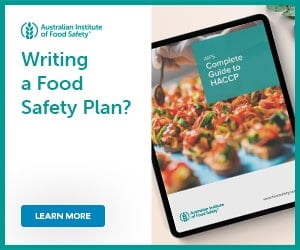
Consistent food safety and high food quality are essential ingredients for the success of any food business. For small businesses, food safety is often dismissed as an afterthought or worse, a costly nuisance, but this couldn’t be farther from the truth. A Food Safety Program is vital for a successful food business.
If your customer service provides your customers’ first taste of your business, food safety and food quality are the aftertaste and what will linger as a memory. When used as a proactive strategy to add value to your food business’ service and reputation, a Food Safety Program can bolster your business’ efficiency, streamline its waste, and prevent food safety hazards that could harm your business.
Applying Standard 3.2.1 – Food Safety Programs
All Australian States and Territories independently interpret and apply the national legislation, Food Standard 3.2.1, which governs the use of Food Safety Programs in Australian food businesses.
Standard 3.2.1 broadly follows international guidelines set out in the Hazard Analysis and Critical Control Point (HACCP) system, which states that food safety is best managed through identifying and controlling hazards at all stages during the production, manufacturing, storage, cooking, and handling of food.
Unfortunately, Standard 3.2.1 is limited in that it does not provide specific instructions on how to develop and implement a Food Safety Program, making tough work for food businesses and Food Safety Supervisors trying to apply the legal requirements in a practical strategy.
The Food Safety Supervisor’s Role
The main goal of a Food Safety Supervisor is to help a food business develop and implement a Food Safety Program that complies with Australian law. The remainder of this article will guide you through the national requirements of a Food Safety Program, as prescribed by the Food Safety Standard 3.2.1, and provide practical tips for how a Food Safety Supervisor can develop and customise a robust Food Safety Program that forms your business’ core competitive strength.
How a Food Safety Program Fits Within the Broad Picture
When developing a Food Safety Program, the Food Safety Supervisor should:
- First, inspect the food business’ current operations
- Second, identify potential food safety hazards and risks that will inform the Food Safety Plan
- Prepare a written Food Safety Program that outlines how the food business will proactively control the identified hazards
- Arrange to have the Food Safety Program audited and verified by the local council before implementing it within the business
- On an ongoing basis, perform measures to control those hazards
- Document those measures within the Food Safety Program
- Keep comprehensive, legible records to demonstrate that the business complies with its Food Safety Program
Taking Apart the HACCP Principles
Standard 3.2.1 states that a Food Safety Program should contain six core elements, consistent with the seven principles of the HACCP system. These are:
- Hazard identification
- Hazard control
- Monitoring
- Corrective action
- Review
- Record keeping
Hazard identification
In order to prevent hazards from occurring, a Food Safety Supervisor first needs to systematically identify all potential hazards that could reasonably occur and make note of these in the Food Safety Program. It’s important to be thorough in this stage; this stage will help the business prevent costly future expenses, such as a food safety emergency like a food poisoning or a food safety complaint.
To start with, list all the steps in a food business’ food preparation activities. This could include:
- Delivery
- Storage
- Preparation
- Cooking
- Chilling
- Reheating
- Serving
- Display
- Transportation
Use a flow diagram or written description to illustrate all of the food preparation steps involved in the business’ food operations. From there, define the microbiological, chemical and physical hazards that could occur at each stage in the flow diagram. Many of these hazards are generic for businesses within each food industry sector, but also consider ‘site-specific’ hazards that could arise in your business because of its unique conditions.
When your food business is audited by an Environmental Health Officer from your local council, they will require that your food business provide evidence that all steps in your food business’ food preparation activities have been identified and documented. This is to ensure that every aspect of your food business has been optimised for food safety.
Hazard control
The next step, hazard control, requires the Food Safety Supervisor to identify where, at each stage of food preparation, each hazard can be controlled and how it will be controlled. Again, consider both generic food safety hazards in your industry and the site-specific hazards unique to your business, and imagine how these could be controlled, i.e. You could apply a procedure to prevent cross-contamination, pests, bacteria growth, or to stop a chemical hazard such as sanitiser from contaminating your food product or its ingredients.
The hazard control section of the Food Safety Program should include advice on limits (referred to as critical limits in HACCP) for the controls. Limits simply refer to the ‘maximum or minimum value to which a physical, biological, or chemical food hazard must be controlled at a critical control point to prevent, eliminate, or reduce it to an acceptable level.’
Ask your Food Safety Supervisor to research effective limits to control each hazard. Note that you must validate all decisions made in the Food Safety Program, so choose your sources of information wisely, making sure they reflect official or expert opinion, otherwise they may be deemed insufficient by your local government. Note that validation is not necessary for limits that are part of Australian food law.
To get your Food Safety Supervisor started on their search, here are a list of possible resources:
- Up-to-date reference books
- Papers from technical journals
- Literature surveys
- Official experimental results
- Codes of practice
- Regulatory standards and guidelines, like the temperature control limit guidelines available in Standard 3.2.2.
When inspecting your business, an Environmental Health Officer will be looking for evidence that:
- The Food Safety Program identifies how each hazard will be controlled and where it is to be controlled
- Each identified food safety hazard is effectively controlled
Monitoring
In the Food Safety Program, the Food Safety Supervisor should provide evidence that the food business is performing regular measurement and observation of each control. Examples of monitoring processes include:
- Inspecting
- Measuring
- Checking
- Observing
The monitoring section of the Food Safety Program document should state who has responsibility for and the frequency of monitoring in your food business, and list an appropriate recording measure for each hazard.
For example, recording measures could be:
- A spreadsheet that an employee fills out when checking food temperatures twice-daily
- A diary that allows written evidence to be collected on an observation and how it met or didn’t meet expectations.
To ensure swift corrective action if a food safety breach arises, all monitoring procedures should outline a corrective action and the point at which the corrective action should be taken.
Corrective Action
A natural evolution of the monitoring stage, developing corrective actions involves outlining solutions to correcting a hazard – or in HACCP terminology, a control point – before a food safety issue occurs. At this stage of developing the Food Safety Program, it might be useful for the Food Safety Supervisor to develop a contingency plan for a food safety emergency like a product recall or customer food poisoning.
When reviewing your Food Safety Program, the Environmental Health Officer will be looking for:
- Evidence of immediate action and investigation into the cause of the hazard
- Evidence that a corrective action has been applied and its results monitored
- The Food Safety Program has been updated with reflections on the incident, outlining steps to prevent the hazard from recurring in the future
Review
Each year, the Food Safety Supervisor should organise a full review of the entire Food Safety Program. This review should:
- Involve procedures to validate that all hazard identification, hazard control, monitoring, and corrective action methods are up-to-date, relevant, and performing adequately
- Provide descriptions of the review activities undertaken
- Consider how often a review must occur and specify a future date for the next review
- List events that may trigger a review
- Include how to record results from the review and how to apply the results to improve the Food Safety Program
- Ultimately, verify that the Food Safety Program achieves its purpose: protecting customers from food safety dangers
Record keeping
The Food Safety Supervisor must constantly keep records to demonstrate compliance with the Food Safety Program. Demonstrating your accountability to Environmental Health Officers (EHOs) will help your business avoid costly food safety fines and reputation damage.
During a food safety inspection, the Food Safety Supervisor might be asked to provide information on the amount and type of record keeping required by a food business to show that its food safety program is effective. This will depend upon the needs and the complexity of the food business and what resources are available to it.
At a minimum, records must be kept for:
- Monitoring actions
- Corrective actions
- A regular review of the program (specifically when the review took place and the outcome)
- Records must be appropriate, legible and indicate:
- What the record relates to
- Who made the record
- The date and where relevant, the time
- The result of what is being recorded
- Any corrective action taken as a result of recording.




